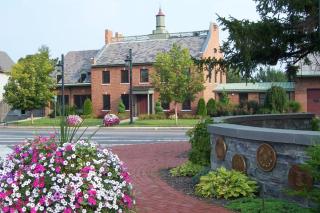Veterans Park

Located in the center of the Village of Fayetteville at the top of the hill, Veterans Park is the focal point of the Village. The park has been known by a number of names over the years including Triangle Park, Legion Park, Center Park, and Genesee Park.
The park welcomes those new to the area or driving through on their daily commute with greenery and a wall of honor featuring all branches of the United States Armed Forces.
Although the park is small in size, there are benches and walkways making it easy to explore the park’s features:
- Flag Pole: In 1937, Village resident Robert Baker bought a flag pole for his home at 310 North Manlius Street and upon realizing it was too large he donated the pole to the Village.
- Grafted Tree: The west section of the park includes a Wheatley Elm (upright position) that has been grafted onto a Smooth-Leafed Elm root.
- Holiday Celebrations: Veterans Park is home to the annual tree-lighting and holiday season celebration held on the day after Thanksgiving.
- Horse Trough: Featured prominently at the east end of the park is a limestone horse watering trough given to the Village in 1892 by Col. John Gaynor in memory of his father. Initially used for its designated purpose, the trough is now a testament to the history of life in the village and features an ornamental fountain.
Park Hours
Closes at dusk
Parking
Village of Fayetteville Municipal Building
On-street (Multiple streets are convenient to the park, please do not park on East Genesee Street to visit Veterans Park)
Park Amenities
Benches
Park History
In 1871, Fayetteville trustees appropriated less than $100 to improve and fence the space at the intersection of three roads, Genesee St., Salt Springs Rd., and Fayetteville-Manlius Rd. An illustration in Clayton's 1878 History of Onondaga County shows the park.
In 1892 Col. John Gaynor donated the horse watering trough in memory of his father, Edward Gaynor, an early settler who owned a limestone quarry and plaster business. This piece was originally placed at the west point of the park. It was moved, probably about 1930, to the east side of the park where it was disconnected from the water supply and functioned in an ornamental fashion with flowers in the drinking trough. In 2003, a small recirculating water system was installed.
In 1937 the Fayetteville Improvement Society bought cedar posts and lumber for park benches which were painted thistle green. A series of benches have been installed and in the 1960s, gravel paths were placed.
The park in the 1960s and 1970s was used for Lions Club Christmas Tree Sales and Boy Scout camp-out projects. A formal sign rack at the west end of the park has replaced the earlier posting of individual signs. Starting in the 1990s, the Fayetteville Garden Club provided and planted bulbs and annuals and members provided maintenance.
One of the prominent features of the park is the unusual grafted tree which is in the west section of the park. Gordon DeAngelo has identified this as a Wheatley (or Jersey) Elm (upright portion) grafted on to a Smooth-Leafed Elm root. Grafting is the only way a Wheatley Elm can be reproduced. I believe that the grafting was done by Samuel J. Wells, who lived at Wellwood (now school site), who cultivated grapes, raspberries, other small fruits and apples.
The current flag pole was given to village about 1937 by Robert Baker, 310 North Manlius St., who bought it for his house and found it too large; accepted by Mayor Kessler and dedicated by American Legion.
In May 2003, village trustees agreed a major $120,00 reconstruction of the park and its surroundings. Part of the money, $24,500 came from the trust fund created when the Fayetteville American Legion Post #369 sold its building in the 100 block of Salt Springs and Spring street in the 1960s and gave the money to the village. In return for using the money, trustees agreed to officially name the park "Fayetteville Veterans' Memorial Park, American Legion Post #369." The plantings by the Fayetteville Garden Club have been removed, a wall built on the west end, brick sidewalks installed and ornamental lighting installed.
